Whatsapp: (+34) 674 381 581
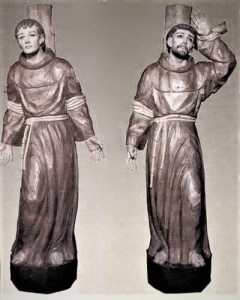 Historiographically it is verified the presence of Turolensis Franciscan Martyrs, Pedro Saxoferrato and Juan de Perusa, and their imprisonment and martyrdom; tortured in the palace named AbdAlah-Salvo (a property owned by Abu-Zayd located outside the Balansiyah city, near of the Boatella Gate), executed (probably at the Figuera Square-current Plaza de la Reina-) and buried first in the Roqueta and then in the Church of St. Bartholomew in 1228.
Historiographically it is verified the presence of Turolensis Franciscan Martyrs, Pedro Saxoferrato and Juan de Perusa, and their imprisonment and martyrdom; tortured in the palace named AbdAlah-Salvo (a property owned by Abu-Zayd located outside the Balansiyah city, near of the Boatella Gate), executed (probably at the Figuera Square-current Plaza de la Reina-) and buried first in the Roqueta and then in the Church of St. Bartholomew in 1228.Ten years later, in May 1238, encamped King James I in Ruzafa besieging Valencia, he promised to his Franciscan directors (Fray Illuminated Rieti and Fray Guillermo de Sede), a large piece of land, outside city walls where the blessed martyrs of the order had suffered imprisonment and torment, so that it could build a convent. So just over a year later, surrendered the city, the monarch c
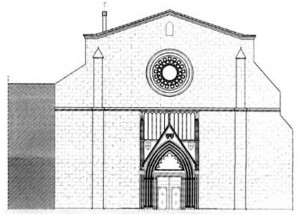 onfirmed the donation and expanded the piece of land with some houses; appearing as major benefactors, King, his wife and the son of the deposed convert Moorish king Abu-Zayd.
onfirmed the donation and expanded the piece of land with some houses; appearing as major benefactors, King, his wife and the son of the deposed convert Moorish king Abu-Zayd.The Convent of Saint Francisco was born as a simple Gothic building, which was progressively expanded to the extent that many nobles were buried within its walls, giving for that large donations. Already in the s. XIV the convent happened to be within the walled area of the city, after the expanding of city walls in 1356 by Peter Ceremonious.
 The first monastic building consisted in church, cloister, refectory and dormitory, for the Franciscan use. The church soon threatened ruin because of their precarious construction, so between 1366 and 1376, was rebuilt following the original Gothic style, but with big and tall buttresses completed by polygonal choir, triple apse and large vaults. The ensemble was completed with two large Gothic cloisters double floor each, Chapter House, a large garden that preceded the entrance of the convent and other gardens at the back, next to the monastic cemetery; All enclosure being surrounded by a wall (occupied almost all of today Town Hall Square, from La Barcelonina street to Telephonic Building are located).
The first monastic building consisted in church, cloister, refectory and dormitory, for the Franciscan use. The church soon threatened ruin because of their precarious construction, so between 1366 and 1376, was rebuilt following the original Gothic style, but with big and tall buttresses completed by polygonal choir, triple apse and large vaults. The ensemble was completed with two large Gothic cloisters double floor each, Chapter House, a large garden that preceded the entrance of the convent and other gardens at the back, next to the monastic cemetery; All enclosure being surrounded by a wall (occupied almost all of today Town Hall Square, from La Barcelonina street to Telephonic Building are located).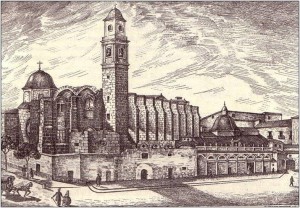 From the s. XIV, the XVII were not performed more than some interventions by way of reform, such as adding a high choir at the church and various decorative ornaments, etc., but in 1675 the church was completely renovated (except for the vaults given its height and complexity) to the Baroque style of the moment, adding a bell tower, with square plan, high-rise and was topped by a rectangular lower body topped by a small doom. In this Baroque renovation was done an exaggerated decorative overload (decorated cornices, corbels on the keys of the arches, etc.), complemented by paintings and altarpieces by artists like Juan de Juanes, Huerta, Espinosa, Vergara, etc…. like a Museum of Sacred Art. Taking place in 1768 within its walls the General Chapter of the Franciscan Order.
From the s. XIV, the XVII were not performed more than some interventions by way of reform, such as adding a high choir at the church and various decorative ornaments, etc., but in 1675 the church was completely renovated (except for the vaults given its height and complexity) to the Baroque style of the moment, adding a bell tower, with square plan, high-rise and was topped by a rectangular lower body topped by a small doom. In this Baroque renovation was done an exaggerated decorative overload (decorated cornices, corbels on the keys of the arches, etc.), complemented by paintings and altarpieces by artists like Juan de Juanes, Huerta, Espinosa, Vergara, etc…. like a Museum of Sacred Art. Taking place in 1768 within its walls the General Chapter of the Franciscan Order. In the year 1805, on a night without consent of the monks it was demolished the wall surrounding the monastery (which already in itself was in bad condition) to make way through the garden joining the current streets of La Sangre and Las Barcas in order to avoid having to make a long detour. In early 1812 Napoleon’s Army invaded Valencia, many monks were exiled, others were shot and the convent was looted. Following the withdrawal of the French (the June 5, 1813) began the Restoration, being in this period misappropriated part of the Baroque additions (although in 1823 a part of the monastery was confiscated for the quartering of troops), regaining full control monks in 1827 and blessed the church again in 1828.
In the year 1805, on a night without consent of the monks it was demolished the wall surrounding the monastery (which already in itself was in bad condition) to make way through the garden joining the current streets of La Sangre and Las Barcas in order to avoid having to make a long detour. In early 1812 Napoleon’s Army invaded Valencia, many monks were exiled, others were shot and the convent was looted. Following the withdrawal of the French (the June 5, 1813) began the Restoration, being in this period misappropriated part of the Baroque additions (although in 1823 a part of the monastery was confiscated for the quartering of troops), regaining full control monks in 1827 and blessed the church again in 1828.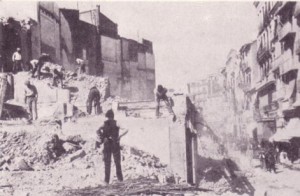 In 1835 came the Confiscation by Decree of Mendizabal, convents were closed, became official or undersold by the Government and the Convent of San Francisco and its dependencies were occupied by the State which established it, the Barracks of Numancia Lancers Cavalry. The presence of the soldiers contributed to the degradation and abandonment of the convent and so in 1891 the monastery of San Francisco was finally demolished; demolition with municipal authorities turned the site left into a garden square and open to the public and trade, which was called Saint Francisco Square.
In 1835 came the Confiscation by Decree of Mendizabal, convents were closed, became official or undersold by the Government and the Convent of San Francisco and its dependencies were occupied by the State which established it, the Barracks of Numancia Lancers Cavalry. The presence of the soldiers contributed to the degradation and abandonment of the convent and so in 1891 the monastery of San Francisco was finally demolished; demolition with municipal authorities turned the site left into a garden square and open to the public and trade, which was called Saint Francisco Square.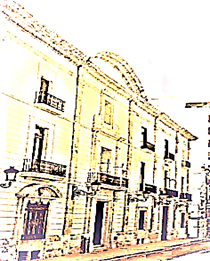 On the other hand the temporary transfer of the City Hall in 1854 (after a fire in the former headquarters) to the House of Education of Archbishop Mayoral, established a new urban centre, opposed to the historical city centre; and around this new centre, many urban transformations gave a new dimension to the area, constituting the ideal scenography for the New Town Hall, when the building of the House of Education was definitely in 1899 the property for City Council and in 1904 began his transformation into new City Hall.
On the other hand the temporary transfer of the City Hall in 1854 (after a fire in the former headquarters) to the House of Education of Archbishop Mayoral, established a new urban centre, opposed to the historical city centre; and around this new centre, many urban transformations gave a new dimension to the area, constituting the ideal scenography for the New Town Hall, when the building of the House of Education was definitely in 1899 the property for City Council and in 1904 began his transformation into new City Hall.The San Francisco Square, step to form the new urban centre, which was to give modern character to be reformed completely with:
1- Demolition of Old Fisherman Area (between Las Barcas street and Central Post Office Building);
2- The transfer of the old Railway Station (from current Telefonica building to its present location) to Játiva Street.
3- The management of the New Square (designed in 1927 by Javier Goerlich) joining three spaces, the Park of San Francisco, the Slope of San Francisco and Cajeros Square, toppling buildings relevant for it and linking Saint Vicent Street and Saint Francisco Square (now Town Hall Square).
 Thus, resulting in the large triangular space that today occupies the current Town Hall Square. These actions were completed with the construction of many monumental buildings (Correos, Balanza, Equitativa, Generali, Barrachina, Adriatica, Cervera, Ferrer, Noguera, Suay, etc.) in Eclectic Style between 1920 and 1936, redefining the old square of San Francisco as a new urban centre, being faithful reflection of successive political events with change name: Plaza San Francisco, Plaza de Espartero, Plaza de Isabel II, Freedom Square, Plaza de Emilio Castelar, Plaza del Caudillo, Plaza del País Valenciano , Plaza del Ayuntamiento..
Thus, resulting in the large triangular space that today occupies the current Town Hall Square. These actions were completed with the construction of many monumental buildings (Correos, Balanza, Equitativa, Generali, Barrachina, Adriatica, Cervera, Ferrer, Noguera, Suay, etc.) in Eclectic Style between 1920 and 1936, redefining the old square of San Francisco as a new urban centre, being faithful reflection of successive political events with change name: Plaza San Francisco, Plaza de Espartero, Plaza de Isabel II, Freedom Square, Plaza de Emilio Castelar, Plaza del Caudillo, Plaza del País Valenciano , Plaza del Ayuntamiento..© FernandoC.
 |
 |
 |
|---|


